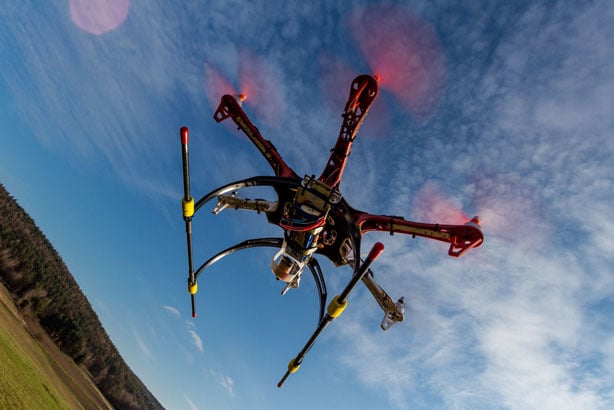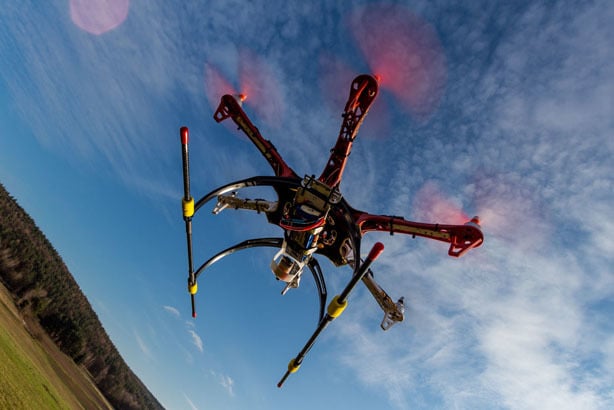

GREENVILLE — Every year around this time the lists of the hottest gifts for the season start popping up, and one item showing up on just about all the lists this year is the unmanned aerial vehicle (UAV) or small unmanned aerial system (sUAS), more commonly known as a “drone.”
The Federal Aviation Administration is estimating that as many as 1 million drones will be given as holiday gifts this season. Although there are fixed-wing UAVs available, for the consumer the vast majority will be the quadcopter version, which has four propellers.
Quadcopters for hobbyists or amateur users can range in price from about $35 for the most basic models up to $1,000 or more. Most are equipped with a camera. The less expensive models usually are operated by means of an included remote control. Pricier versions may operate via an app downloaded to your smartphone.
Micro quadcopters can cost even less. These are often small enough to fit in the palm of your hand and usually are not equipped with a camera, although some are.
Government regulations regarding UAVs have been developing and evolving as the aircraft have grown quickly in popularity.
The FAA recently released a task force report recommending that the agency should offer registration of drones, including those used by amateur fliers, for drones weighing from a half pound up to 55 pounds.
Registration would allow the FAA to more easily provide educational materials and updates on regulations to UAV owners, as well as allow the agency to track operators in case of an accident. However, the proposal, as it stands, would have the registration process be voluntary.
UAV guidelines issued by the agency include altitude and proximity limitations. (The FAA was tasked with issuing regulations on drone use by September of 2015, but those regulations have not yet been finalized.)
The FAA has several guidelines on its website for sUAS recreational users, knowbeforeyoufly.org:
• Follow community-based safety guidelines, as developed by organizations such as the Academy of Model Aeronautics (AMA).
• Fly no higher than 400 feet and remain below any surrounding obstacles when possible.
• Keep your sUAS in eyesight at all times, and use an observer to assist if needed.
• Remain well clear of and do not interfere with manned aircraft.
• Do not intentionally fly over people, moving vehicles or vulnerable property.
• Contact the airport or control tower before flying within five miles of an airport.
• Do not fly in poor weather conditions.
• Do not fly under the influence of alcohol or drugs.
• Only fly in safe areas with a competent operator.
•Do not fly near or over sensitive areas such as power stations, water treatment facilities, correctional facilities, heavily traveled roadways, government facilities, etc.
•Check and follow all local laws and ordinances before flying over private property.
• Do not conduct surveillance or photograph persons in areas where there is an expectation of privacy without the individual’s permission (see AMA’s privacy policy).
Additional safety guidelines and rules for use are available on a downloadable brochure on the site. The brochure may be accessed directly at http://knowbeforeyoufly.org/wp-content/uploads/sites/34/2015/12/KBYF_Brochure_WEB.pdf
For those looking to buy a drone, there are several things to keep in mind, in addition to safe practices:
• UAVs can be difficult to fly. The less expensive models can be unstable and especially hard to control. All models will require practice and care to learn how to fly correctly and safely. New UAV pilots must keep in mind the learning curve for operating their aircraft, or it could very well end up a pile of scrap right out of the box.
• Not all drones are ready to fly as purchased. Drones are usually labelled with an industry acronym to indicate the level of set-up required to get the craft in the air. RTF, BNF and ARF are the typical ones.
RTF means Ready To Fly. These don’t require assembly or any significant set-up, but the user may need to do some simple things such as charging the battery or attaching the propellers.
BNF means Bind And Fly. These are usually fully assembled but without a controller. The user will need to “bind” the aircraft either to a controller sold separately or a smartphone app. These may require guidance from an experienced user.
ARF means Almost Ready to Fly, but this can be misleading. The definition is quite broad and could mean that the kit comes without a transmitter, receiver, flight controller or even a motor or battery. Some level of assembly will be required and some additional components may be required. Buyers looking at ARF kits are encouraged to read the label carefully to know exactly what they are getting and what skill level is required to get it functional.
• Commercial use regulations are much more strict. Hobbyists can fly their drone for recreational purposes, but if they are making any money from the aircraft (selling photos or using them for commercial purposes) they need to apply for a Section 333 waiver through the FAA. The waiver also requires the operator to have a pilot’s license to fly the drone commercially. As the final regulations are resolved, that requirement may be relaxed to allow a commercial drone pilot to have drone certification.
• State and local regulations may vary. Rules will differ from location to location on drone use, so a hobbyists flying around in their own backyard will need to be aware of the rules before taking the aircraft anywhere else. According to the National Conference of State Legislatures, 45 states have considered 168 bills related to UAVs so far this year, and 26 states have some kind of drone laws on the books. Ohio does not currently have any drone legislation.





